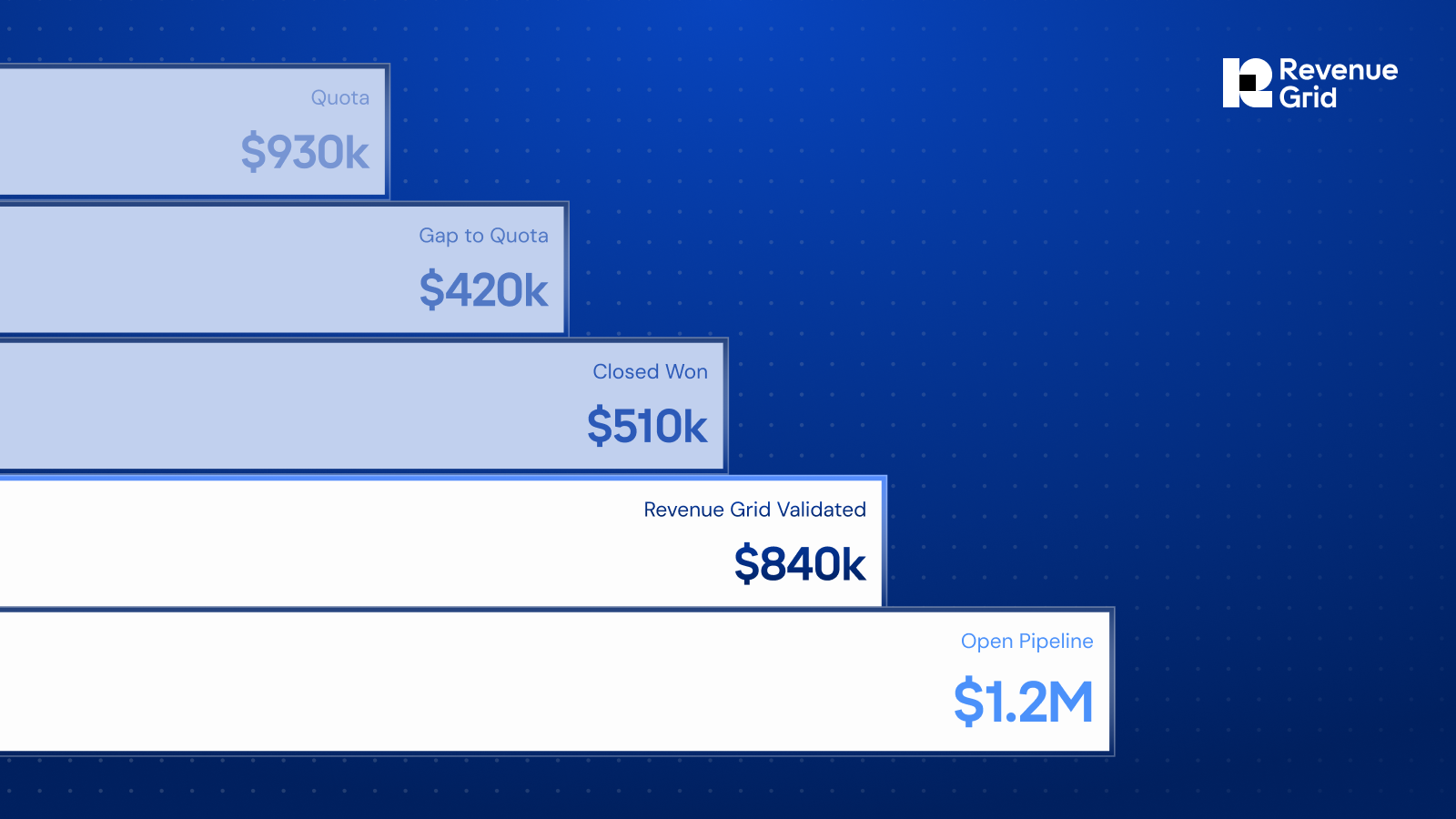Key Takeaway
- How to Build a Clear, Connected View of Your Sales Pipeline
- Common blockers include fragmented tools, low CRM adoption, and manual activity tracking.
- Automating data capture, centralizing insights, and reviewing signal-based activity improve pipeline accuracy.
- Revenue Grid enhances Salesforce by syncing all communication channels and surfacing live engagement signals.
- Real-time visibility helps every role, from reps to executives, make confident, data-driven decisions.
Every quarter brings higher revenue targets, yet many sales teams still operate in the dark. They rely on CRMs built for data entry, not for the way modern sales actually happen. Conversations unfold across emails, LinkedIn messages, calls, and meetings, but only fragments make it into the system.
That’s why pipeline visibility often feels like guesswork. Dashboards show deal stages, but not the buyer’s real intent or engagement level. The result? Forecasts drift from reality, reviews turn reactive, and strategy leans on assumptions instead of evidence.
This article breaks down how to fix that. You’ll see how to capture actual buyer activity across every channel, connect it into one reliable view, and understand how platforms like Revenue Grid make that clarity possible, without extra admin work.
Why Sales Pipeline Visibility Is More Than Just Data
Pipeline visibility isn’t about how much data you have, it’s about how meaningful that data is. Many leaders believe they can “see” their pipeline because they can pull a report or glance at a dashboard. But that’s only a surface-level snapshot.
CRMs show what reps record, not what buyers do. A deal tagged as Negotiation might involve daily calls with the CFO or complete silence for weeks. Without real-time engagement signals, it’s impossible to tell the difference.
True visibility means seeing every opportunity as it actually stands: backed by live activity data from emails, calls, meetings, and social channels. Without that context, sales conversations turn into detective work, forecasts go stale, and leadership ends up planning around outdated information.
The best teams flip that equation. They capture every buyer interaction automatically, interpret signals as they happen, and act before deals cool off. That’s where visibility becomes a competitive advantage instead of a checkbox metric.
When Visibility Disappears: Real-World Examples
Even industry leaders have learned the hard way what happens when visibility fades.
DocuSign: Overestimated Demand, Missed Forecasts
During the pandemic, DocuSign’s sales pipeline looked unstoppable. But by 2022, demand slowed and leadership didn’t see it in time. Forecasts stayed optimistic, deals were over-valued, and when results fell short, investor confidence crashed. Stock prices dropped nearly 60%, and the CEO stepped down.
Lesson: Data lag can mask reality. When pipelines reflect old momentum instead of live activity, strategy derails.
Palantir: Weak Billings, Investor Skepticism
In 2024, Palantir’s revenue rose slightly, but billings stalled at 2%. The company hadn’t seen deal slowdowns coming due to incomplete visibility into renewals. Analysts downgraded the stock, causing an 8% one-day dip.
Lesson: A pipeline that “looks” healthy on paper may hide weak engagement underneath.
Engineering Firms: Missed Projects, Costly Over-Hiring
According to Consult Australia’s 2024 report, 57% of engineering and HVACR firms had to cut staff when anticipated projects vanished. Without visibility into delays or cancellations, they over-hired and over-planned.
Lesson: When deal and project visibility disappear, so does stability. Missed signals lead to layoffs, delays, and poor planning decisions.
These examples show what happens when sales data lives in silos, communication channels don’t connect, and key buyer signals never make it into your CRM. The result? Everyone’s guessing. But when teams fix visibility, everything changes. Reps sell smarter, managers coach faster, RevOps forecasts more accurately, and leadership gains the clarity to plan with confidence.
Who Gains the Most From Pipeline Visibility?
Visibility benefits every level of the organization, from frontline sellers to the C-suite.
For Sales Reps: More Selling, Less Admin
Reps lose countless hours to CRM updates. According to Salesforce’s 2024 State of Sales report, only 28% of their time goes to actual selling. Automating activity capture solves that.
Every email, call, and meeting should be logged automatically, so reps don’t waste time typing notes. They enter reviews with a complete record of buyer engagement and can focus on next steps, not cleanup.
Takeaway: Less manual work, faster follow-ups, and better quota attainment.
For Sales Managers: Coaching With Context
Managers can’t guide effectively if they don’t know what’s really happening in deals. With full visibility, they can coach based on real signals, for example: delays in meeting cadence or missed stakeholder responses.
Takeaway: Coaching becomes timely and specific, improving win rates and consistency.
For RevOps and Finance: Accurate Forecasts
RevOps depends on clean, consistent data to predict revenue and plan headcount. When visibility improves, so does forecasting accuracy.
Takeaway: Real-time data keeps forecasts stable, budgets predictable, and confidence high.
For Executives: Credibility and Control
CROs, CFOs, and CEOs trust in the numbers. When forecasts reflect live buyer engagement, executives can present confidently to boards and investors, backed by verifiable activity data.
Takeaway: Leadership earns credibility through accurate, signal-based insights.
5 Proven Ways to See What’s Really Happening in Your Pipeline
Your sales pipeline tells a story, but only if you can read all its pages. Emails, LinkedIn DMs, calls, meetings, and Slack messages all contain signals about buyer intent. The problem? Those signals live in silos. Unless they’re automatically captured and connected, they stay hidden.
Here’s how top-performing teams pull those threads together and build a living, breathing view of their pipeline.
1. Capture Every Buyer Interaction Automatically
Calendar syncs and email plugins might look helpful on the surface, but they only scratch it. They miss unopened proposals, quiet decision-makers, and meetings that never had a follow-up. Those gaps create a shallow view of deal health.
RevenueGrid changes that. It automatically captures every interaction, across email, LinkedIn, calls, and meetings, and syncs it directly into Salesforce. No manual updates. No missed context. Just a clear, real-time trail of buyer engagement that drives accurate forecasting and sharper coaching conversations.

Effortlessly sync Salesforce with Outlook and Gmail to prevent conflicts and streamline scheduling
2. Create a Single Source of Pipeline Truth
Think about your forecast calls: Sales, RevOps, and Leadership are all looking at “the pipeline,” but through different lenses. Spreadsheets, exports, BI dashboards, none of them align perfectly.
When each team sees a different version of reality, strategy breaks down. High-performing teams fix this by unifying data across systems. Everyone, from SDRs to the CRO, works from the same live pipeline view, grounded in shared facts rather than stale snapshots.
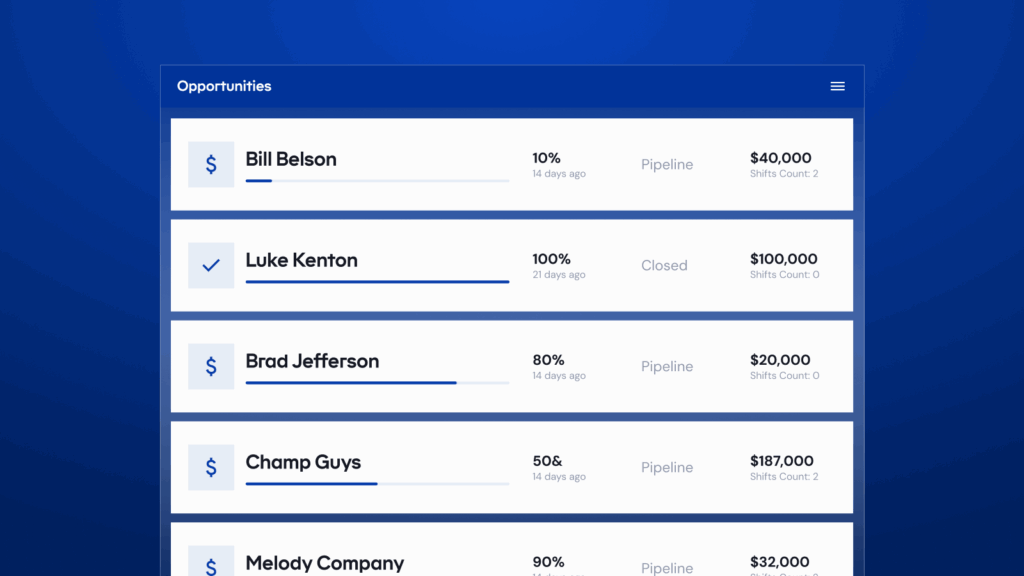
Get full visibility of every stage of your pipeline with Revenue Grid
3. Use Live Buyer Signals to Coach, Not Chase
If a manager still needs to ask, “Did they reply?” or “Who’s actually involved?”, the system isn’t doing its job. CRMs record activity, but they don’t reveal intent. A deal might look healthy on paper while the buyer has quietly stopped engaging.
Coaching should be proactive, not post-mortem. When live buyer signals like reply rates, meeting cadence, or stakeholder engagement are visible, managers can focus 1:1s where they matter most.Instead of reviewing lost deals, they can step in early to prevent them. That shift turns coaching into deal acceleration, not deal rescue.

Get a real-time view of what’s happening in your pipeline
With RevenueGrid, those signals surface automatically, giving managers context before they even open a report.
4. Keep Your CRM Clean Without Manual Cleanup
Every sales team dreams of a “clean” CRM. Few actually have one. Deals linger long after they’re lost, fields go blank, duplicates pile up and suddenly, every forecast becomes a guessing game.
Manual cleanup doesn’t scale. And pulling reps away from selling to update data defeats the purpose.
RevenueGrid automates that hygiene layer. It flags inactive deals, fills missing fields, and standardizes entries through Salesforce-native mapping. Your CRM stays accurate and forecast-ready, without constant supervision. A clean pipeline is the foundation of predictable revenue.
5. Track Internal Progress Like You Track Buyer Engagement
Deals don’t just stall externally. Many get stuck inside your own walls. A pricing approval sits in Finance. Legal takes a week longer than expected. An executive signoff slips past quarter-end. From the outside, it looks like the deal is moving. Internally, it’s frozen. hose bottlenecks rarely show up in a CRM, which makes forecasts look healthier than they are.
Top teams treat internal steps with the same visibility as external ones. They track ownership, dependencies, and handoffs across departments. It’s how they spot slowdowns before they snowball into missed quarters.
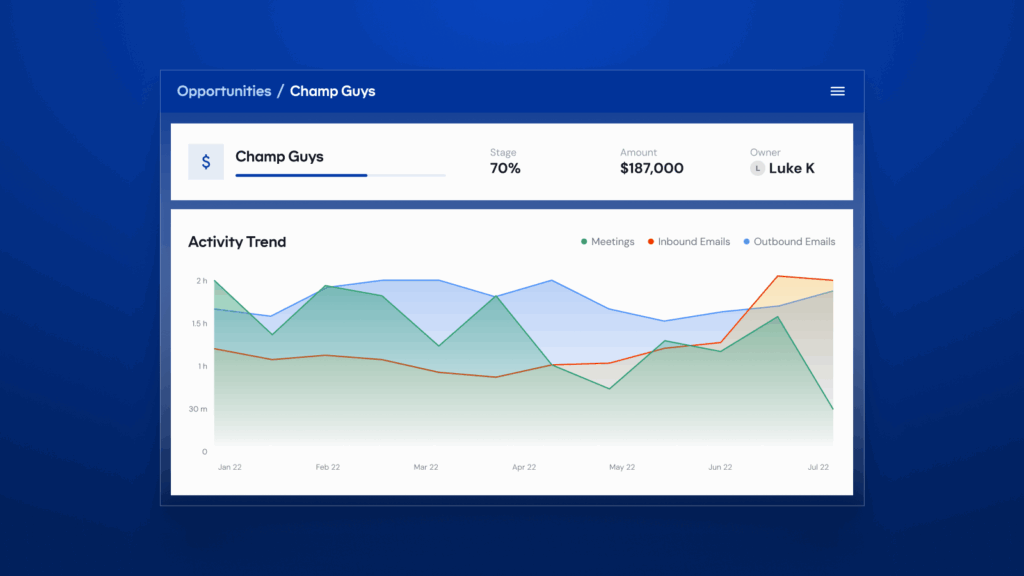
Sales activity trends for Champ Guys opportunity with meetings, inbound, and outbound emails visualized over time
How Revenue Grid Improves Sales Pipeline Visibility
Revenue Grid gives Salesforce-first teams the clarity to act with precision by automatically capturing and interpreting engagement across all channels.
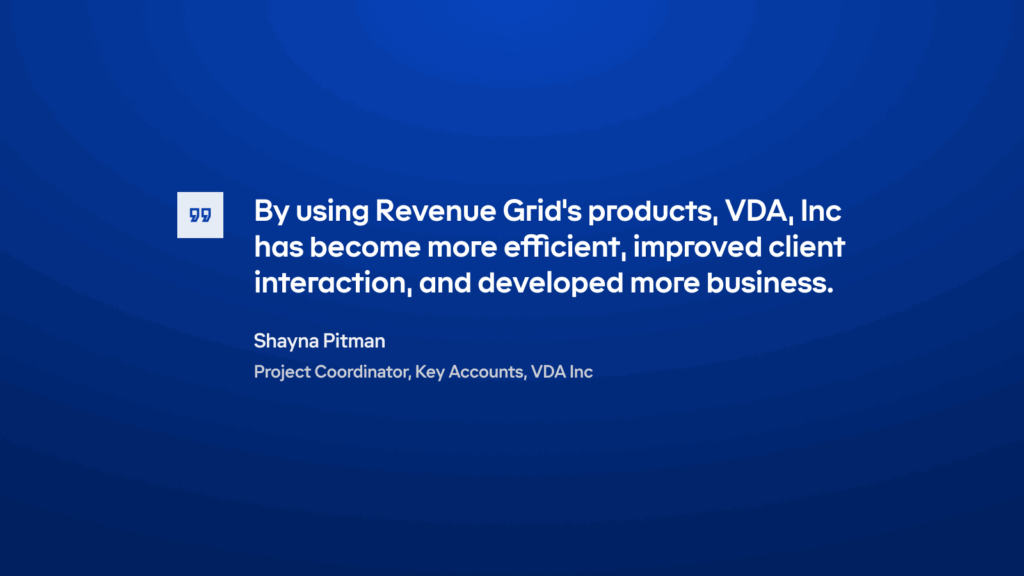
The Account sales managers at StarWind Inc. appreciates Revenue Grid for giving them excellent pipeline visibility
Here’s how:
- Multichannel Engagement: Captures every touchpoint from email, meetings, and calls.
- Signal-Based Selling: Uses live activity signals to detect stalled deals or buying intent.
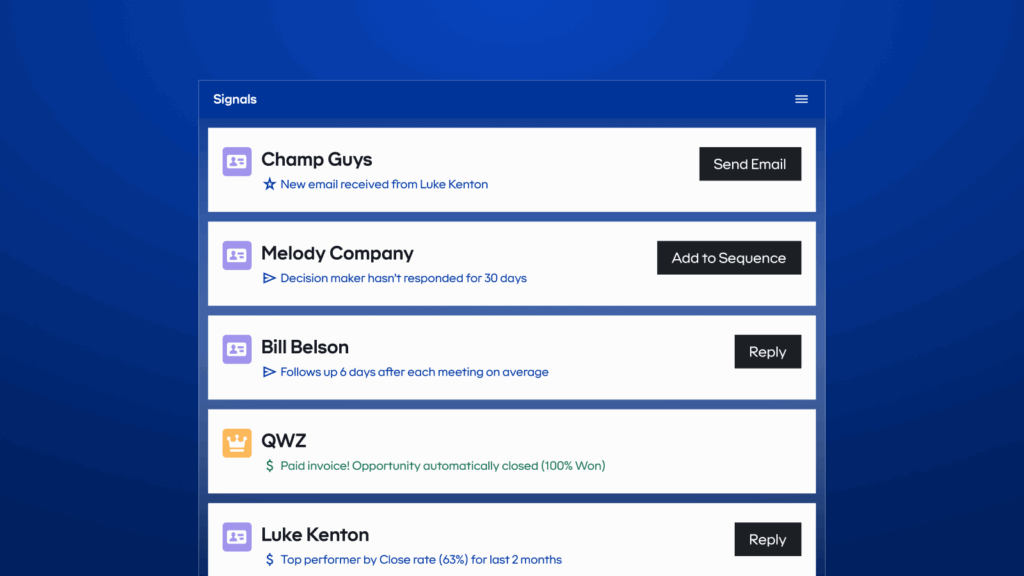
Get real-time alerts of important pipeline activities
- Automated Workflows: Sends alerts, reminders, and next steps directly into Salesforce.
- AI-Powered Forecasting: Learns from patterns and engagement trends to improve forecast accuracy.

See how far along deals are moving across the pipeline
- Unified Visibility: Gives Sales, RevOps, and Leadership one shared view of the pipeline in real time.
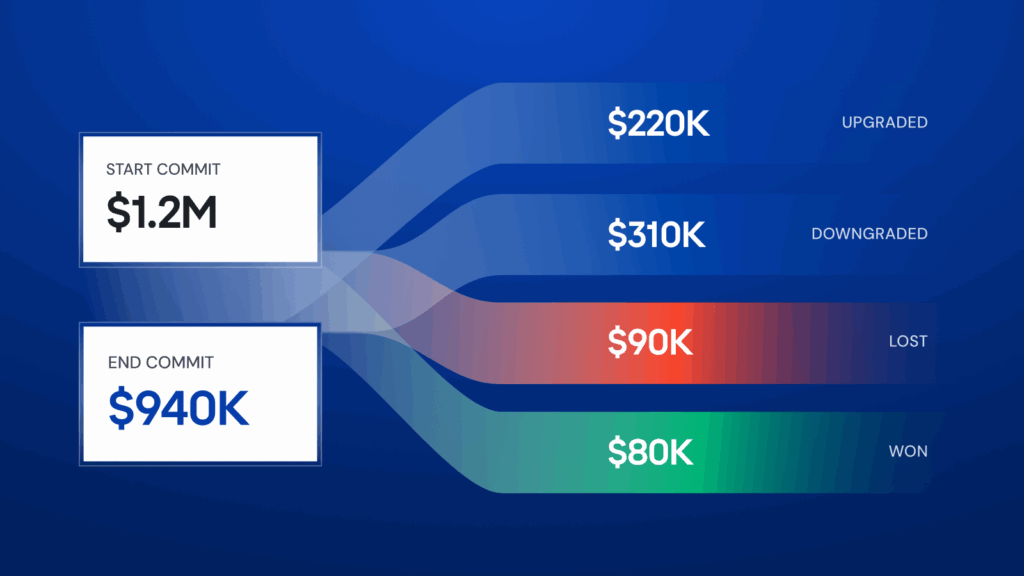
Get a unified visibility of idle deals, downgrades, wins, losses, and slipped opportunities
When your communication channels speak to each other, your sales process finally makes sense and your forecasts stop being fiction.
See the Whole Picture, Not Just the CRM Snapshot
Sales success doesn’t hinge on more data, it depends on seeing what the data actually means. When every email, meeting, and message is connected, your pipeline stops being a spreadsheet and starts becoming a story you can read in real time.
That’s what Revenue Grid delivers: signal-based visibility that tells you what’s happening, what’s slipping, and what to do next, all without extra admin work.
When your team can see deals clearly, everything else aligns:
- Reps focus on selling, not chasing updates
- Managers coach based on facts, not assumptions.
- RevOps forecasts with confidence, not caution.
- Executives plan growth backed by reality, not guesswork.
Clarity drives consistency. And consistent execution is what turns a forecast into predictable growth.
Ready to see your pipeline clearly and close with confidence? Book a personalized demo with Revenue Grid
How often should pipeline reviews be conducted?
Weekly reviews work best for maintaining momentum. They help sales leaders spot stalled deals early, review engagement activity, and adjust forecasts while there’s still time to act.
How does AI help detect risk in the sales pipeline?
AI identifies patterns that humans often miss such as declining email responses, slower meeting cadences, or fewer stakeholders involved. Revenue Grid uses these signals to surface alerts before deals stall.
What are the biggest signs of poor pipeline visibility?
Common warning signs include inconsistent forecasts, missing activity logs, outdated CRM data, and sales meetings spent debating deal status instead of strategy.
How can teams improve CRM hygiene without more admin work?
Automate it. Use tools that flag incomplete records, sync communication history, and standardize data formats automatically like Revenue Grid’s Salesforce-native cleanup engine.
What’s the best way to track activity across multiple channels?
Integrate all key communication tools like Gmail, Outlook, LinkedIn, Zoom with your CRM. Revenue Grid automates this process, logging every interaction and creating one reliable view of the entire customer journey.
How does pipeline visibility affect forecasting accuracy?
When engagement data flows automatically into Salesforce, forecasts shift from assumptions to facts. Leaders can see deal health in real time, spot risk earlier, and make informed revenue projections with far fewer surprises.
